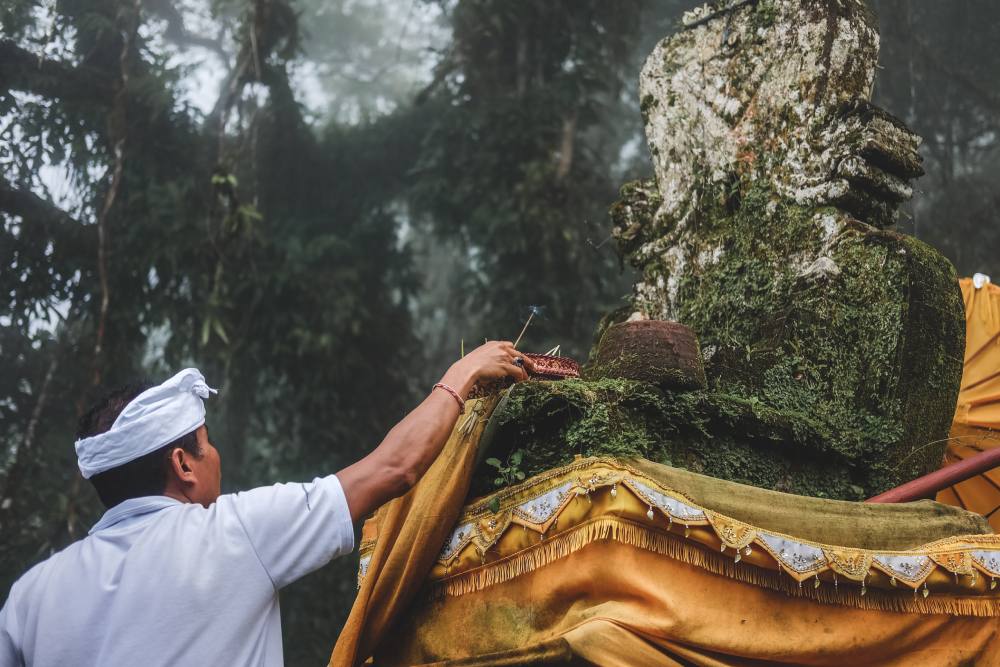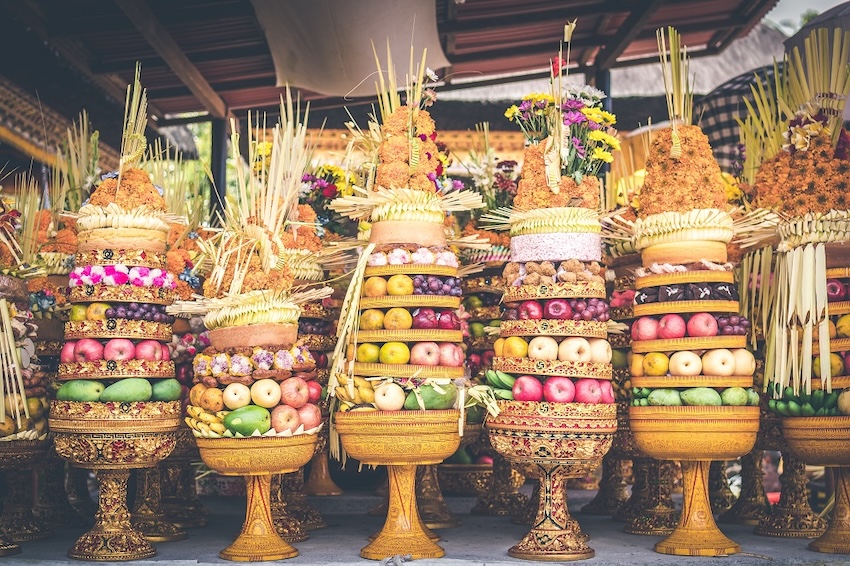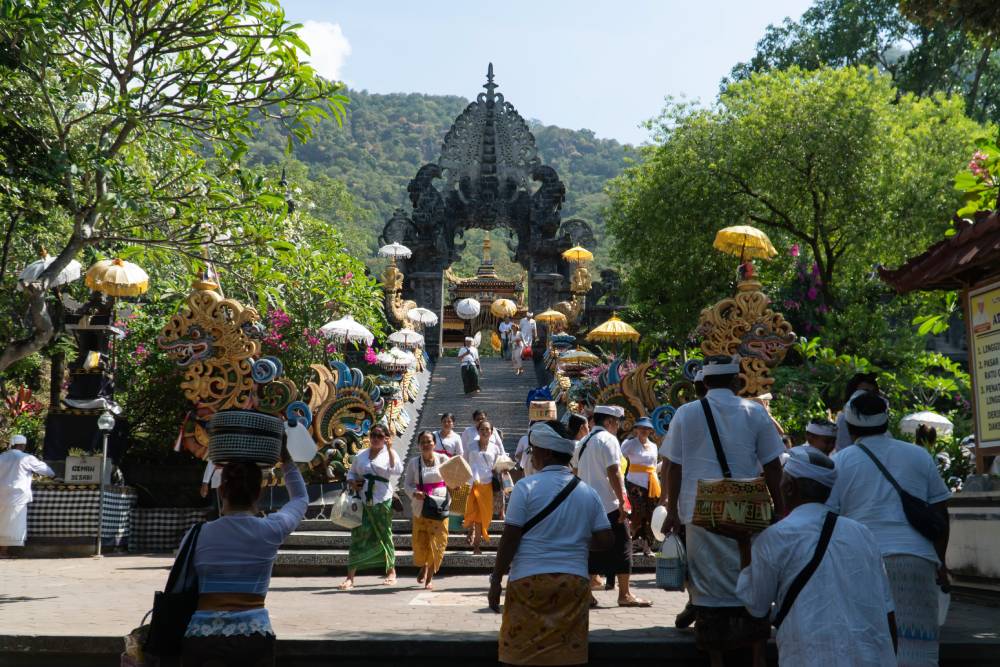
Amongst the estimated 17,000 islands that make up the Indonesian archipelago, one shines brighter than them all. This island has been called many names: The Morning of the World, Island of Peace, Island of Love. The name that resonates the most however, is The Island of the Gods.
Sandwiched between the fiery island of Java and a wild, rugged Lombok, Bali has lived through an incredibly diverse history; a history that has created the truly unique place it is today. But what exactly makes this island so distinct from the rest of Indonesia, and indeed, the world? And most importantly, why is Bali called the island of the Gods?
Listen to the Podcast Episode: Understanding Bali: An Introduction to the Island of the Gods
iTunes • Spotify • Google Podcasts • Pocket Casts • Radio Public
A Brief History of Bali
Indian influences, spread around the Indonesian archipelago from the 6th century onwards, diffused through the islands by the many tradesmen, travelling missionaries, kingdoms and empires. Most influential was the Hindu-Javanese Majapahit Empire, which reigned over the Indonesian archipelago from 1293 to 1527.
The Majapahit Empire invaded Bali in 1343, a moment that has had long-lasting effects on the island. The royal courts became conduits for cultural influence on the island, bringing literature, art, music and dance from their East Javanese origins. After the fall of the Majapahit Empire, the priestly and the princely fled to Bali, further introducing notions of caste and cementing the cultural heritage of the island. So, whilst most of the rest of the Indonesian archipelago underwent a centuries-long religious transformation toward Islam, quiet Bali retained its own brand of Hinduism. Many Balinese see their culture as the living continuation of the Majapahit Empire.
Hindu Dharma: Why Bali is Called the Island of the Gods

Of course, it is clear for those who have been to India that the Hinduism practiced in Bali is very much its own. This is due to the island’s past animist beliefs, upon which the Hindu teachings and philosophies have been superimposed.
Dewi Sri, the Goddess of Rice, along with Dewi Danu, Goddess of the Lake were the deities to worship, whose blessings would secure the wellbeing of Bali’s agrarian livelihoods. Nature, and the spirits found within it, were what was considered holy. The great Mount Agung, towering in the east where the sun would rise, was seen as holiest of all.
In Hindu Dharma, the name of Balinese modern Hinduism, many of these beliefs still have a place in rites and rituals. Temples and shrines are positioned in accordance to Mount Agung; ancient trees wrapped in poleng checkered cloth, presented with offerings to placate the spirit that lives within. Even Dewi Sri herself has been absorbed into the tenets of this newfound religion.
Understanding this idea of ‘manifestations’ of the One God is a key to understanding worship on the island. In Bali’s particular brand of Hinduism, pervaded by its animist past, God is thought to be in everything and all around us. Sang Hyang Widhi Wasa – the singular, Supreme God – is always present, but not directly. He manifests Himself in different forms depending on location, function or even position. At the sea temples like Pura Tanah Lot, the Balinese Hindu pray to Bhatara Segara, God of the Sea; in their village-based Pura Dalem temple, they will pray to Bhatara Dalem. It is for this reason Bali is given the name Island of the Gods.
Even modern Hinduism’s Trimurti of Shiva, Vishnu and Brahma are considered manifestations (or avatars) of Sanghyang Widhi Wasa. Where god ‘sits’ on a shrine, or pelinggih (meaning seat), they will manifest into the appropriate form, presented with offerings and prayers for a certain function.
Ancestors are equally as important to the Balinese Hindu; they are often given as much attention as the gods, if not more! Temple ceremonies are dedicated to them. In Bali’s interpretation of samsara, the cycle of reincarnation, ancestors are reincarnated amongst their kin. Thus much attention goes into the both birth and death rituals and ceremonies, ensuring a smooth entrance and exit of the soul between worlds.
Beyond Belief: Bali’s Living Culture

Religion plays a key role in defining what Bali is all about. This is because it pervades mere worship and bleeds into every part of Balinese daily life. From the daily routines of a Balinese worker to the prayers of the high priest, rite and ritual can be seen throughout the day.
Without the presence of its gods and ancestors, the island would not be blessed with the creation of its extraordinary temples, built in locations equally as impressive. From Pura Tanah Lot, seemingly floating out at sea, to Pura Besakih, Bali’s mother temple that climbs up the southern face of Mount Agung.
Religion also inspired the vibrant visual and performing arts. The wayang shadow puppet theatre shows and Kamasan paintings of Kerta Gosa presenting the stories of Hindu epics; the Sanghyang Dedari dance and accompanying gamelan paying tribute to the gods and ancestors. The wooden mask carvers sculpting the faces of folklore, in hopes its bearer shall reach taksu and embody the very essence of his or her character.
The Balinese belief system, and associated traditions, has created the foundation for a living, breathing culture. In turn, it gives life to the rest of the island, too. Would Mount Agung still command such an aura of reverence if it were not considered the abode of the gods? Would the same sagging banyan trees still exude a sense of mysticism if they were not wrapped in cloth and presented offerings? Would the temples emanate their magic if prayers and pilgrimage no longer called upon the ancestors and deities?
The likely answer is no. The daily wafting of incense is the breath that fills this island’s lungs; the ceremonial processions like blood cells, constantly pumping, keeping Bali’s spiritual energy flowing. The beliefs, traditions and practices give story and meaning to the mundane places, objects and environments experienced on an everyday basis.
For further reading:
• Agama Tirta : Bali’s Religion of Water
• Canang Sari : Bali’s Daily Offering
• Changes in Balinese Hinduism










